
The Province of Upper Canada was a part of British Canada established in 1791 by the Kingdom of Great Britain, to govern the central third of the lands in British North America, formerly part of the Province of Quebec since 1763. Upper Canada included all of modern-day Southern Ontario and all those areas of Northern Ontario in the Pays d'en Haut which had formed part of New France, essentially the watersheds of the Ottawa River or Lakes Huron and Superior, excluding any lands within the watershed of Hudson Bay. The "upper" prefix in the name reflects its geographic position along the Great Lakes, mostly above the headwaters of the Saint Lawrence River, contrasted with Lower Canada to the northeast.

Thayendanegea or Joseph Brant was a Mohawk military and political leader, based in present-day New York, who was closely associated with Great Britain during and after the American Revolution. Perhaps the Native American of his generation best known to the Americans and British, he met many of the most significant Anglo-American people of the age, including both George Washington and King George III.

The County of Brant is a single-tier municipality in the Canadian province of Ontario. Although it retains the word "county" in its name, the municipality is a single-tier municipal government and has no upper tier. The County of Brant has service offices in Burford, Paris, Oakland, Onondaga and St. George. The largest population centre is Paris.
Clergy reserves were tracts of land in Upper Canada and Lower Canada reserved for the support of "Protestant clergy" by the Constitutional Act of 1791. One-seventh of all surveyed Crown lands were set aside, totaling 2,395,687 acres (9,695 km2) and 934,052 acres (3,780 km2) respectively for each Province, and provision was made to dedicate some of those reserved lands as glebe land in support of any parsonage or rectory that may be established by the Church of England. The provincial legislatures could vary or repeal these provisions, but royal assent could not be given before such passed bills having been laid before both houses of the British Parliament for at least thirty days.

Six Nations is demographically the largest First Nations reserve in Canada. As of the end of 2017, it has a total of 27,276 members, 12,848 of whom live on the reserve. It is the only reserve in North America that has representatives of all six Haudenosaunee nations living together. These nations are the Mohawk, Cayuga, Onondaga, Oneida, Seneca and Tuscarora. Some Lenape also live in the territory.
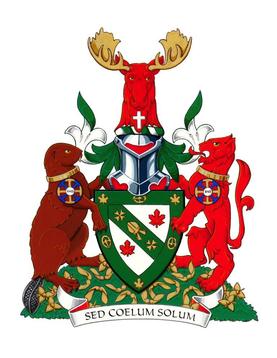
Renison University College is an affiliated university college of the University of Waterloo and located in Waterloo, Ontario, Canada. Renison's campus is situated on the western border of Waterloo's main campus. The university college offers academic programs that count as credit toward a University of Waterloo degree. Most academic courses are offered within Waterloo's Faculty of Arts, focusing on social sciences, language and culture.

Same-sex marriage in Ontario has been legal since June 10, 2003. The first legal same-sex marriages performed in Ontario were of Kevin Bourassa to Joe Varnell, and Elaine Vautour to Anne Vautour, by Reverend Brent Hawkes on January 14, 2001. The legality of the marriages was questioned and they were not registered until after June 10, 2003, when the Court of Appeal for Ontario in Halpern v Canada (AG) upheld a lower court ruling which declared that defining marriage in heterosexual-only terms violated the Canadian Charter of Rights and Freedoms.
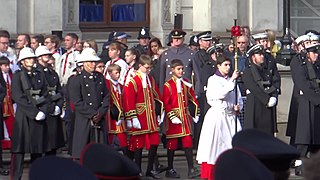
The Chapel Royal is an establishment in the Royal Household serving the spiritual needs of the sovereign and the British Royal Family. Historically it was a body of priests and singers that travelled with the monarch. The term is now also applied to the chapels within royal palaces, most notably at Hampton Court and St James's Palace, and other chapels within the Commonwealth designated as such by the monarch. Within the Church of England, some of these royal chapels may also be referred to as Royal Peculiars, an ecclesiastical jurisdiction of the monarch. The Dean of His Majesty's Chapels Royal is a royal household office that in modern times is usually held by the Bishop of London.

The Anglican Church of Canada is the province of the Anglican Communion in Canada. The official French-language name is l'Église anglicane du Canada. In 2017, the Anglican Church counted 359,030 members on parish rolls in 2,206 congregations, organized into 1,571 parishes. The 2011 Canadian census counted 1,631,845 self-identified Anglicans, making the Anglican Church the third-largest Canadian church after the Catholic Church and the United Church of Canada. The 2021 Canadian census counted more than 1 million self-identified Anglicans, remaining the third-largest Canadian church. Like other Anglican churches, the Anglican Church of Canada's liturgy utilizes a native version of the Book of Common Prayer, the 1962 prayer book. A further revision, the 1985 Book of Alternative Services, has developed into the dominant liturgical book of the church.

Molly Brant, also known as Mary Brant, Konwatsi'tsiaienni, and Degonwadonti, was a Mohawk leader in British New York and Upper Canada in the era of the American Revolution. Living in the Province of New York, she was the consort of Sir William Johnson, the British Superintendent of Indian Affairs, with whom she had eight children. Joseph Brant, who became a Mohawk leader and war chief, was her younger brother.

Huron University College is a university college affiliated with the University of Western Ontario in London, Ontario, Canada. Incorporated on 5 May 1863, Huron is the founding institution of the University of Western Ontario.

Christ Church, His Majesty's Chapel Royal of the Mohawk is located on the Tyendinaga Mohawk Territory near Deseronto, Ontario, Canada. It is owned by the Mohawks of the Bay of Quinte First Nation and is associated with the Anglican Parish of Tyendinaga, Diocese of Ontario. It was designated as a National Historic Site in 1995 and is one of only three Chapels Royal in Canada, elevated by the Queen in 2004.
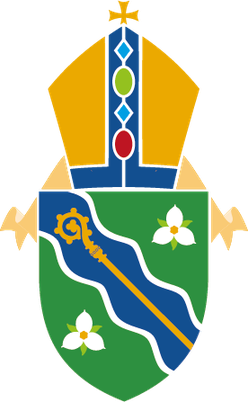
The Diocese of Niagara is one of thirty regional divisions in the Anglican Church of Canada. The see city of the diocese is Hamilton, with the bishop's cathedra located at Christ's Church Cathedral on James Street North. Located within the ecclesiastical province of Ontario, it borders the Dioceses of Huron and Toronto. The area enclosed by the Diocese of Niagara includes much of the Golden Horseshoe, and moves north to include Erin and Orangeville as far as Shelburne. Moving sharply south the line includes Mount Forest and widens, south-westerly to include Elora and Guelph. Skirting Brantford and the Territory of the Six Nations Confederacy, the line then travels, again, south-westerly to Nanticoke and Lake Erie to include the entire Niagara Peninsula. Major urban centres within its borders are St. Catharines, Niagara Falls, Hamilton, Guelph, Oakville, Milton, Burlington, and Orangeville.
The Very Reverend is an honorific style given to higher-ranking members of a clergy. The definite article "the" should always precede "Reverend" when used before a name, because "Reverend" is an honorific adjective, not a title.
The Diocese of Toronto is an administrative division of the Anglican Church of Canada covering the central part of southern Ontario. It was founded in 1839 and is the oldest of the seven dioceses comprising the Ecclesiastical Province of Ontario. It has the most members of any Anglican diocese in Canada. It is also one of the biggest Anglican dioceses in the Americas in terms of numbers of parishioners, clergy and parishes. As of 2018, the diocese has around 230 congregations and ministries in 183 parishes, with approximately 54,000 Anglicans identified on parish rolls.
The Diocese of Huron is a diocese of the Ecclesiastical Province of Ontario of the Anglican Church of Canada. The diocese comprises just over 31,000 square kilometres in southwestern Ontario, sandwiched between Lake Huron and Lake Erie. Its See city is London, and its parish rolls of 50,000 are served by 177 congregations.
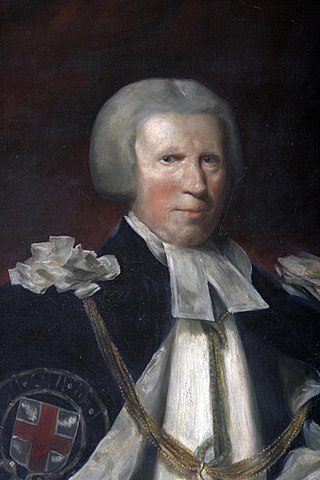
Sir George Pretyman Tomline, 5th Baronet was an English clergyman, theologian, Bishop of Lincoln and then Bishop of Winchester, and confidant of William Pitt the Younger. He was an opponent of Catholic emancipation.

The Haldimand Proclamation was a decree that granted land to the Mohawk who had served on the British side during the American Revolution. The decree was issued by the Governor of the Province of Quebec, Frederick Haldimand, on October 25, 1784, three days after the Treaty of Fort Stanwix was signed between others of the Six Nations and the American government. The granted land had to be purchased from the Mississaugas of the Credit whose traditional territory spans much of modern day Southwestern Ontario. On May 22, 1784 Col. John Butler was sent to negotiate the sale of approximately 3,000,000 acres of land located between Lakes Huron, Ontario, and Erie for £1180.00 from the Mississaugas of the Credit. Of the land ceded, some 550,000 acres were granted to the Mohawk nation in the Haldimand Proclamation. The sale by the Mississaugas of the Credit is also referred to as the "Between the Lakes Treaty."
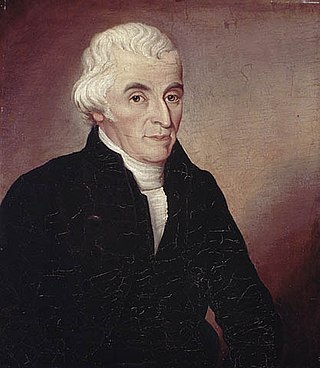
John Stuart was a Church of England clergyman, missionary, educator, and Loyalist. He is noted for being the first chaplain of the Legislative Council of Upper Canada, for being the first Anglican priest in what is now Ontario, for building the first church in what is now Kingston, Ontario, and for opening the first grammar school in Upper Canada.

William Grant Cliff is Bishop of the Anglican Diocese of Brandon, in Canada. Born in 1966, in Sarnia, Ontario and raised in nearby Wyoming, Ontario.




















